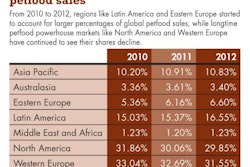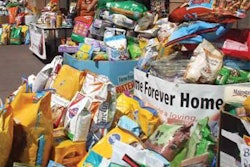Petfood product development follows human food trends by only "half a step," said David Sprinkle, research director and publisher with Packaged Facts, during a Petfood Forum 2013 presentation. That was just three months ago; judging by information presented at the Institute of Food Technologists (IFT) Annual Meeting and Food Expo this week, I am beginning to think that perhaps petfood has already caught up and is marching in lock step with human food in many areas.
During the IFT meeting and expo, I sat in on a presentation on health and wellness trends in food by Mintel and found trend-packed graphics in the Innova Market Insights booth. The top 10 trends culled from Innova's database were particularly interesting:
1. The aware shopper--Innova described the "increasingly informed shopper, who is more knowledgeable about value and health." This profile has been prevalent among more involved pet parents for several years now.
2. Health traffic jam--according to Innova, little is happening in functional food innovation, "as if everyone is swirling around the same topics all the time and waiting for someone to jump." This intrigued me, considering that some people in our industry (myself included) have commented on a lack of true innovation in petfood for a while now--though perhaps when it comes to functional ingredients for petfood, innovation is still more likely as the research is still lagging a little behind that on functional benefits for humans.
It's worth noting that in its presentation, Mintel focused on noteworthy health and wellness food trends for humans, focusing on drivers such as weight control, longevity, cognition and "healthy enjoyment" (people wanting to eat healthy while still enjoying food). While as trends these aren't necessarily new, Mintel did show new ingredients and products hitting the market in those categories.
Of course, those first three drivers--weight control, longevity and cognition--are also driving product development in petfood, too.
3. Gray but healthy--food can be part of the solution to the large aging human population, Innova said, "with a greater understanding of the role a healthy diet can have on extending the active years." Not only does that parallel Mintel's focus on longevity, but it also applies to petfood.
4. Protein overdrive--human food is seeing ever-increasing label claims for "high protein," just as we're seeing in petfood.
5. Just say no--another mirror image of the scene in petfood, with increasing "free-from" claims, including ones showing up on both human food and petfood packages, such as "gluten free."
6. Beating the sugar demon--not really applicable to petfood, though one could argue that our industry has its own "demons." (By-products, anyone?)
7. Natural cracks emerge--"After years of solid growth for natural marketed products, we have reached a tipping point," Innova said, as US regulators and lawsuits are creating pressure for companies producing processed human foods with "natural" claims. Such companies are switching to "additive/preservative free" claims, according to Innova.
US retail sales of natural petfood grew at a compound annual growth rate of 18% from 2008 to 2012, according to Packaged Facts, which predicts the category to increase 17% annual through at least 2017. It will be interesting to see if these same "cracks" emerge for petfood companies marketing natural products.
8. Sensory experience--Innova's term for "fun foods" that provide a moment of escapism during touch economic times, with increasing development of texture/flavor/taste experience. This may be similar to Mintel's healthy enjoyment driver; I'm not sure if there's a parallel in petfood product development, despite the industry's continued work in palatability as well as texture and shape of kibble.
9. More with less--reducing packaging materials as well as using sustainable ingredients, yet another area where petfood is at least keeping pace with human food, I believe.
10. Extreme interest--product development in human food seems to be concentrating around the ends of the market, Innova said; for example, toward babies and seniors or both economy and superpremium categories. In some markets around the world, we're seeing the same concentrations toward the lower and higher ends for petfood in terms of price categories.
Finally, I should note that the IFT meeting did include a session on product development in petfood at a very basic, "30,000-foot" level, obviously geared toward people with little to no experience with our industry.


















